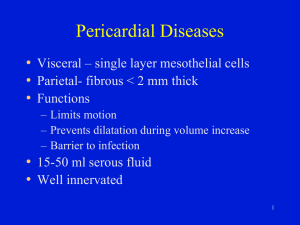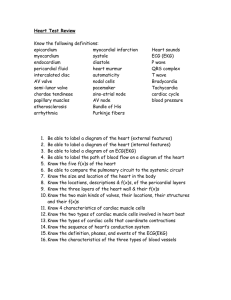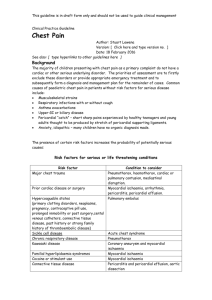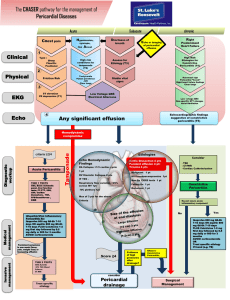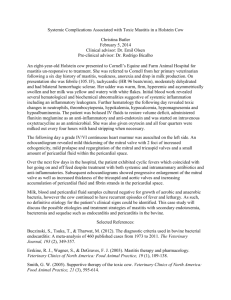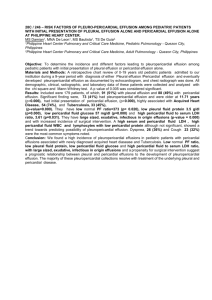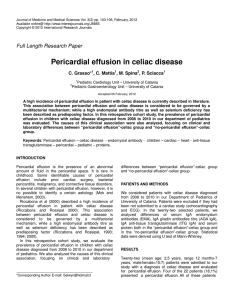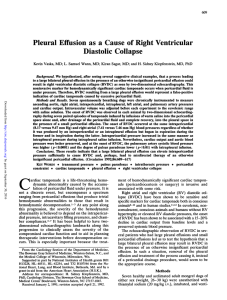Hospital Course Introduction
advertisement
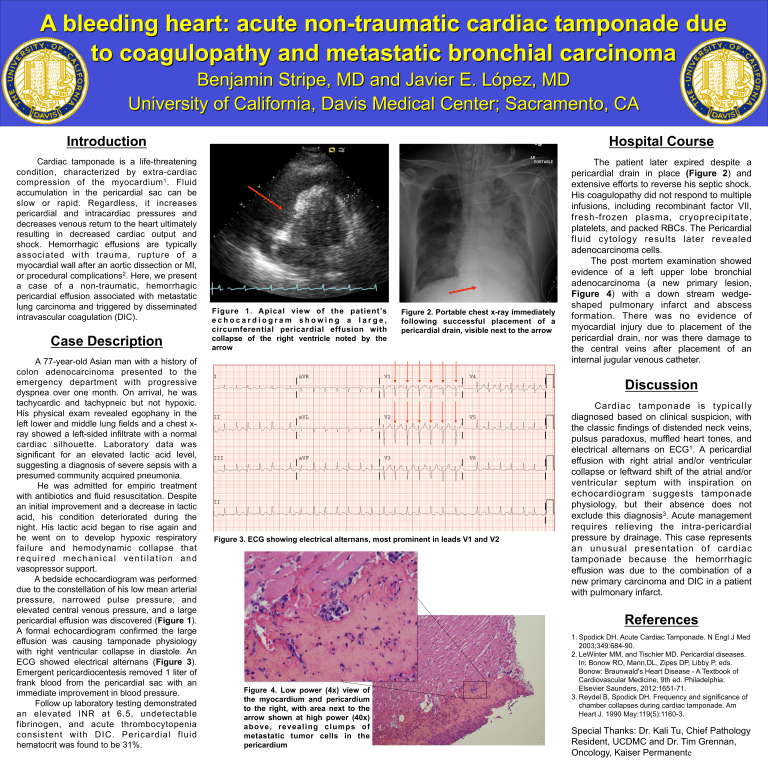
A bleeding heart: acute non-traumatic cardiac tamponade due to coagulopathy and metastatic bronchial carcinoma Benjamin Stripe, MD and Javier E. López, MD University of California, Davis Medical Center; Sacramento, CA Introduction Hospital Course Cardiac tamponade is a life-threatening condition, characterized by extra-cardiac compression of the myocardium 1 . Fluid accumulation in the pericardial sac can be slow or rapid. Regardless, it increases pericardial and intracardiac pressures and decreases venous return to the heart ultimately resulting in decreased cardiac output and shock. Hemorrhagic effusions are typically associated with trauma, rupture of a myocardial wall after an aortic dissection or MI, or procedural complications2. Here, we present a case of a non-traumatic, hemorrhagic pericardial effusion associated with metastatic lung carcinoma and triggered by disseminated intravascular coagulation (DIC). The patient later expired despite a pericardial drain in place (Figure 2) and extensive efforts to reverse his septic shock. His coagulopathy did not respond to multiple infusions, including recombinant factor VII, fresh-frozen plasma, cryoprecipitate, platelets, and packed RBCs. The Pericardial fluid cytology results later revealed adenocarcinoma cells. The post mortem examination showed evidence of a left upper lobe bronchial adenocarcinoma (a new primary lesion, Figure 4) with a down stream wedgeshaped pulmonary infarct and abscess formation. There was no evidence of myocardial injury due to placement of the pericardial drain, nor was there damage to the central veins after placement of an internal jugular venous catheter. Case Description A 77-year-old Asian man with a history of colon adenocarcinoma presented to the emergency department with progressive dyspnea over one month. On arrival, he was tachycardic and tachypneic but not hypoxic. His physical exam revealed egophany in the left lower and middle lung fields and a chest xray showed a left-sided infiltrate with a normal cardiac silhouette. Laboratory data was significant for an elevated lactic acid level, suggesting a diagnosis of severe sepsis with a presumed community acquired pneumonia. He was admitted for empiric treatment with antibiotics and fluid resuscitation. Despite an initial improvement and a decrease in lactic acid, his condition deteriorated during the night. His lactic acid began to rise again and he went on to develop hypoxic respiratory failure and hemodynamic collapse that required mechanical ventilation and vasopressor support. A bedside echocardiogram was performed due to the constellation of his low mean arterial pressure, narrowed pulse pressure, and elevated central venous pressure, and a large pericardial effusion was discovered (Figure 1). A formal echocardiogram confirmed the large effusion was causing tamponade physiology with right ventricular collapse in diastole. An ECG showed electrical alternans (Figure 3). Emergent pericardiocentesis removed 1 liter of frank blood from the pericardial sac with an immediate improvement in blood pressure. Follow up laboratory testing demonstrated an elevated INR at 6.5, undetectable fibrinogen, and acute thrombocytopenia consistent with DIC. Pericardial fluid hematocrit was found to be 31%. Figure 1. Apical view of the patient’s echocardiogram showing a large, circumferential pericardial effusion with collapse of the right ventricle noted by the arrow Figure 2. Portable chest x-ray immediately following successful placement of a pericardial drain, visible next to the arrow Discussion Figure 3. ECG showing electrical alternans, most prominent in leads V1 and V2 Cardiac tamponade is typically diagnosed based on clinical suspicion, with the classic findings of distended neck veins, pulsus paradoxus, muffled heart tones, and electrical alternans on ECG1. A pericardial effusion with right atrial and/or ventricular collapse or leftward shift of the atrial and/or ventricular septum with inspiration on echocardiogram suggests tamponade physiology, but their absence does not exclude this diagnosis3. Acute management requires relieving the intra-pericardial pressure by drainage. This case represents an unusual presentation of cardiac tamponade because the hemorrhagic effusion was due to the combination of a new primary carcinoma and DIC in a patient with pulmonary infarct. References Figure 4. Low power (4x) view of the myocardium and pericardium to the right, with area next to the arrow shown at high power (40x) a bov e , r e v e a l ing c lum ps of metastatic tumor cells in the pericardium 1. Spodick DH. Acute Cardiac Tamponade. N Engl J Med 2003;349:684-90. 2. LeWinter MM, and Tischler MD. Pericardial diseases. In: Bonow RO, Mann,DL, Zipes DP, Libby P, eds. Bonow: Braunwald's Heart Disease - A Textbook of Cardiovascular Medicine, 9th ed. Philadelphia: Elsevier Saunders, 2012:1651-71. 3. Reydel B, Spodick DH. Frequency and significance of chamber collapses during cardiac tamponade. Am Heart J. 1990 May;119(5):1160-3. Special Thanks: Dr. Kali Tu, Chief Pathology Resident, UCDMC and Dr. Tim Grennan, Oncology, Kaiser Permanente
